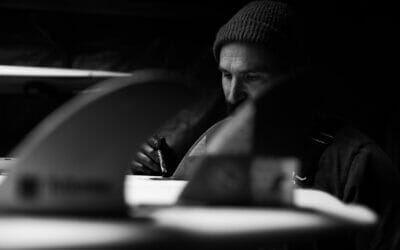A work breakdown is your ultimate to do list, giving you clarity, sanity, and yep, even more creative freedom inside of your conservation photography project.
Here’s how to build one for your photography project!
In the previous article, we discovered the magic of a scope of work – your trusty sidekick in maintaining sanity and boosting creativity throughout a conservation photography project. With your goals, expectations, and timeframes set, you might think it’s time to dive in headfirst, right?
Hold on! There’s another essential tool you’ll need: a work breakdown.
In this article, we’ll explore how a work breakdown is your ultimate to-do list, providing you with a sense of calm and, believe it or not, even more creative freedom within your conservation photography project.
Why a work breakdown is essential for your photography projects
Think of a work breakdown as your trail map to success. It’s a comprehensive list of all the tasks needed to complete your project.
While it may seem tedious, especially when planning familiar tasks, there are a few critical reasons why it’s worth the effort:
1. Avoid surprises that can slow your progress: Investing a little time to think through all necessary tasks reduces the chances of unexpected obstacles. Sure, life will always throw curveballs, but with most work identified, you’ll have fewer surprises and be better equipped to handle them.
2. Free your creativity: A fun project, let alone a successful one, means that you enjoy what you’re doing and can enjoy the results of your effort. And a big reason why something is enjoyable is because it goes smoothly. Set your expectations and parameters right away so that you can relax into the work and free your creative mind to have a blast with your project.
3. Control change rather than letting change control you: The more structure you create upfront, the more flexibility you’ll have during your project. A clear understanding of the work involved early on allows you to make decisions with clarity and confidence when surprises arise or changes occur.
4. Make it faster and easier to plan future projects: Many photography projects look similar in structure. If you put the work into creating a detailed work breakdown now, you can recycle it for future projects. Just cut, paste, mildly customize, and off you go!
It may seem challenging at first, but trust me; it gets easier.
Now that you understand the importance of a work breakdown let’s look at how to create one.
Preparation for making a work breakdown
Drafting a work breakdown is a fun process that helps you suss out everything that’ll go into a project – and often even helps you come up with ideas for the project you wouldn’t have thought of before.
To begin:
1. Set aside 1-2 hours to draft your first version, but don’t worry about perfection. Plan for revisions and additional details as your project progresses.
2. Have your scope of work handy for reference, as you’ll pull from this for the work breakdown.
A scope of work and a work breakdown complement each other beautifully. Imagine the scope of work as an aerial view of the landscape you’re about to explore, and the work breakdown is the detailed trail map to guide you to your destination.
Ready to embark on your next conservation photography adventure? With a scope of work and a work breakdown in hand, you’ll be well-prepared to navigate the journey ahead.
How to draft a work breakdown for a photography project in 7 steps
So, what goes into a work breakdown? There are seven sections that I always include:
1. Objective
This can be the same as the scope of work premise or more specific to this particular work breakdown. For example, suppose you’re working on a large project with multiple components. In that case, your work breakdown can address just one part of the overall project.
2. Deliverables
These can be pasted in from your scope of work or made more specific if you’re working on a particular chunk of a project. They’re the actual products of your work – the physical artifacts that you’ll hand over to a client, gallery, or publisher when you’re done with the project.
3. Out of Scope
Just as you need to write out what you’re doing, it’s essential to note what you’re not doing. This prevents your project from snowballing into something too big or vague to accomplish.
4. Tasks
This is the core of a work breakdown. It’s your opportunity to sit down and think about all the little things involved in accomplishing a task.
This section of the work breakdown is especially important because getting clear on the tasks involved in pulling off a project informs how long it’ll really take to create – which informs the schedule, the cost estimates, and more.
It’s easy to list a few big, obvious tasks and call it a day. But that’s misleading – there’s usually much more to do hiding under the surface of those big, obvious tasks.
In the long run, it pays off to dig deeper during this section and figure out all that’s REALLY involved in the tasks. So, let’s take a closer look at how quickly one task can reveal itself to be a whole list of tasks when you pay attention to detail.
To illustrate this point, let’s consider a simple example: scheduling the photography portion of a story assignment.
At first glance, it seems pretty straightforward – check your calendar, pencil in some fieldwork dates, and you’re good to go, right? Well, not quite.
When you dig deeper, you’ll find that you also need to coordinate with your contacts, make travel arrangements, organize gear, rent equipment, and more.
Suddenly, that “quick” fieldwork turns into several days of preparation, and we haven’t even touched on the shoot itself, let alone processing photos and editing them yet!
By breaking down each task into its various components, you gain a realistic understanding of the time and effort required for your project. Plus, once you’ve done this in-depth analysis, you can easily recycle and adapt it for future projects – making your life that much easier!
Another significant benefit of a detailed work breakdown is that it helps you create a manageable schedule.
Let’s say you’re pitching to a new editor and think you can write and send the pitch in just one day. But when you examine all the necessary steps – like getting feedback, selecting images, and writing captions – you may realize it’s actually a week’s worth of work.
Having a clear picture of the time needed for each task allows you to craft a realistic schedule, preventing that overwhelming feeling of being swamped or caught off guard by unexpected tasks.
With a well-planned work breakdown, you can breathe easy and focus on what you love – capturing incredible images and telling impactful stories.
So, the fourth section of a work breakdown, the Tasks, is your key to unlocking a smoother, more enjoyable project experience. Embrace the power of thorough planning and watch your photography projects thrive!
5. Cost Estimates
Including cost estimates is important for two reasons: practicality and strategy. Knowing how much you’ll spend helps with budgeting while strategically identifying tasks that may still be overlooked. For instance, budgeting for rental gear could remind you to research, price, schedule rentals, and factor in shipping times – tasks that might have been missed otherwise. By examining costs, you minimize obstacles and potential surprises, getting ahead of the curve.
6. Schedule
After outlining tasks thoroughly, create a timeline for accomplishing them. The trick is to work backward from the due date, ensuring everything is in order.
If your schedule seems tight, there are three ways to handle it:
- Rejigger or delete non-mission-critical tasks.
- Adjust deliverables to fit the available time.
- Renegotiate deadlines with clients before starting the project.
Scheduling brings the work breakdown map together, allowing you to see the project’s realities and adjust your plan accordingly. This clarity provides the freedom to be creative, focused, energized, and professional throughout the entire project.
7. Links to other resources
This is where you ensure you have quick access to everything you’re using for your project, such as budget sheets and contact lists. Having these at your fingertips keeps you organized and informed.
And there you have it! The seven sections of a work breakdown.
A detailed work breakdown and timeline are essential tools for maintaining organization and clarity throughout a conservation photography project.
By carefully planning tasks, budgets, and schedules, you can minimize obstacles and surprises, ultimately leading to greater success and creativity.
So, embrace the power of a well-planned work breakdown and watch your conservation photography projects flourish!












